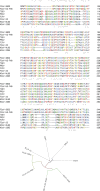In Silico Assessment for Risk of Possible Human Transmission of FCoV-23
- PMID: 40303145
- PMCID: PMC12017019
- DOI: 10.1155/2024/8398470
In Silico Assessment for Risk of Possible Human Transmission of FCoV-23
Abstract
Since the pandemic in 2019, coronaviruses (CoVs) have been a great concern for public health burden. The fact that CoVs can infect all animals including domestic ones and livestock points to a future pandemic even though interaction between human and wildlife animals is restricted. Moreover, interspecies transmission abilities of CoVs by mutations make them drastically risky not only for humans but also for animal health. Recently, a new CoV outbreak in cats in Cyprus, the so-called FCoV-23, has been realized. In addition to worries over animal health, any possible transmission to humans is now controversial. However, there have been limited characterization studies on FCoV-23. Thus, we aimed to assess the possible transmission of FCoV-23 to humans using in silico prediction tools. Accordingly, we first checked the binding affinities of receptor binding domain (RBD) of FCoV-23 against feline target protein and its human homolog. Next, we randomly and rationally created mutations on the RBD sequence and evaluated the binding affinities using protein docking tools. Our results underlined that multiple mutations at the same time were needed for increased binding affinity towards human target protein, demonstrating that the probability of transmission to humans was extremely low when mutation rates were regarded. Still, further molecular studies are required to comprehensively conclude the possible transmission risk.
Keywords: Cyprus; coronaviruses; feline; in silico modeling.
Copyright © 2024 Ahmet Caglar Ozketen et al.
Conflict of interest statement
The authors declare no conflicts of interest.
Figures



Similar articles
-
Serological Screening for Coronavirus Infections in Cats.Viruses. 2019 Aug 13;11(8):743. doi: 10.3390/v11080743. Viruses. 2019. PMID: 31412572 Free PMC article.
-
Prevalence of Korean cats with natural feline coronavirus infections.Virol J. 2011 Sep 28;8:455. doi: 10.1186/1743-422X-8-455. Virol J. 2011. PMID: 21951835 Free PMC article.
-
Molecular detection using hybridization capture and next-generation sequencing reveals cross-species transmission of feline coronavirus type-1 between a domestic cat and a captive wild felid.Microbiol Spectr. 2024 Oct 3;12(10):e0006124. doi: 10.1128/spectrum.00061-24. Epub 2024 Aug 19. Microbiol Spectr. 2024. PMID: 39158411 Free PMC article.
-
Mind the feline coronavirus: Comparison with SARS-CoV-2.Gene. 2022 May 30;825:146443. doi: 10.1016/j.gene.2022.146443. Epub 2022 Mar 22. Gene. 2022. PMID: 35337854 Free PMC article. Review.
-
Feline coronavirus in multicat environments.Vet Clin North Am Small Anim Pract. 2011 Nov;41(6):1133-69. doi: 10.1016/j.cvsm.2011.08.004. Vet Clin North Am Small Anim Pract. 2011. PMID: 22041208 Free PMC article. Review.
References
MeSH terms
LinkOut - more resources
Full Text Sources
Miscellaneous

